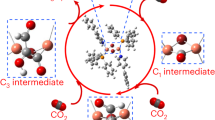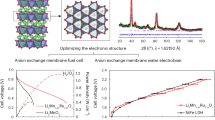Abstract
The oxygen evolution reaction has an important role in many alternative-energy schemes because it supplies the protons and electrons required for converting renewable electricity into chemical fuels1,2,3. Electrocatalysts accelerate the reaction by facilitating the required electron transfer4, as well as the formation and rupture of chemical bonds5. This involvement in fundamentally different processes results in complex electrochemical kinetics that can be challenging to understand and control, and that typically depends exponentially on overpotential1,2,6,7. Such behaviour emerges when the applied bias drives the reaction in line with the phenomenological Butler–Volmer theory, which focuses on electron transfer8, enabling the use of Tafel analysis to gain mechanistic insight under quasi-equilibrium9,10,11 or steady-state assumptions12. However, the charging of catalyst surfaces under bias also affects bond formation and rupture13,14,15, the effect of which on the electrocatalytic rate is not accounted for by the phenomenological Tafel analysis8 and is often unknown. Here we report pulse voltammetry and operando X-ray absorption spectroscopy measurements on iridium oxide to show that the applied bias does not act directly on the reaction coordinate, but affects the electrocatalytically generated current through charge accumulation in the catalyst. We find that the activation free energy decreases linearly with the amount of oxidative charge stored, and show that this relationship underlies electrocatalytic performance and can be evaluated using measurement and computation. We anticipate that these findings and our methodology will help to better understand other electrocatalytic materials and design systems with improved performance.
This is a preview of subscription content, access via your institution
Access options
Access Nature and 54 other Nature Portfolio journals
Get Nature+, our best-value online-access subscription
$29.99 / 30 days
cancel any time
Subscribe to this journal
Receive 51 print issues and online access
$199.00 per year
only $3.90 per issue
Buy this article
- Purchase on Springer Link
- Instant access to full article PDF
Prices may be subject to local taxes which are calculated during checkout





Similar content being viewed by others
Data availability
All data are available in the main text or the supplementary materials and from the Open Research Data Repository of the Max Planck Society, https://doi.org/10.17617/3.48. Source data are provided with this paper.
Change history
05 January 2021
A Correction to this paper has been published: https://doi.org/10.1038/s41586-020-03101-x.
References
Gür, T. M. Review of electrical energy storage technologies, materials and systems: challenges and prospects for large-scale grid storage. Energy Environ. Sci. 11, 2696–2767 (2018); correction 11, 3055–3055 (2018).
Seh, Z. W. et al. Combining theory and experiment in electrocatalysis: insights into materials design. Science 355, eaad4998 (2017).
Hu, C., Zhang, L. & Gong, J. Recent progress made in the mechanism comprehension and design of electrocatalysts for alkaline water splitting. Energy Environ. Sci. 12, 2620–2645 (2019).
Marcus, R. A. Electron transfer reactions in chemistry. Theory and experiment. Rev. Mod. Phys. 65, 599–610 (1993).
Marcus, R. A. Theoretical relations among rate constants, barriers, and Brønsted slopes of chemical reactions. J. Phys. Chem. 72, 891–899 (1968).
Seitz, L. C. et al. A highly active and stable IrOx/SrIrO3 catalyst for the oxygen evolution reaction. Science 353, 1011–1014 (2016).
Nong, H. N. et al. A unique oxygen ligand environment facilitates water oxidation in hole-doped IrNiOx core–shell electrocatalysts. Nat. Catal. 1, 841–851 (2018).
Schmickler, W. & Santos, E. Interfacial Electrochemistry (Springer, 2010).
Shinagawa, T., Garcia-Esparza, A. T. & Takanabe, K. Insight on Tafel slopes from a microkinetic analysis of aqueous electrocatalysis for energy conversion. Sci. Rep. 5, 13801 (2015); correction 10, 6899 (2020).
De Faria, L. A., Boodts, J. F. C. & Trasatti, S. Electrocatalytic properties of ternary oxide mixtures of composition Ru0.3Ti(0.7−x)CexO2: oxygen evolution from acidic solution. J. Appl. Electrochem. 26, 1195–1199 (1996).
Lyons, M. E. G. & Brandon, M. P. A comparative study of the oxygen evolution reaction on oxidised nickel, cobalt and iron electrodes in base. J. Electroanal. Chem. (Lausanne) 641, 119–130 (2010).
Mefford, J. T., Zhao, Z., Bajdich, M. & Chueh, W. C. Interpreting Tafel behavior of consecutive electrochemical reactions through combined thermodynamic and steady state microkinetic approaches. Energy Environ. Sci. 13, 622–634 (2020).
Corrigan, D. A. The catalysis of the oxygen evolution reaction by iron impurities in thin film nickel oxide electrodes. J. Electrochem. Soc. 134, 377 (1987).
Pearce, P. E. et al. Revealing the reactivity of the iridium trioxide intermediate for the oxygen evolution reaction in acidic media. Chem. Mater. 31, 5845–5855 (2019).
Grimaud, A. et al. Activation of surface oxygen sites on an iridium-based model catalyst for the oxygen evolution reaction. Nat. Energy 2, 16189 (2017); erratum 2, 17002 (2017).
Augustyn, V., Simon, P. & Dunn, B. Pseudocapacitive oxide materials for high-rate electrochemical energy storage. Energy Environ. Sci. 7, 1597–1614 (2014).
Conway, B. E. in Electrochemical Supercapacitors: Scientific Fundamentals and Technological Applications (ed. Conway, B. E.) 221–257 (Springer, 1999).
Kuo, D. Y. et al. Influence of surface adsorption on the oxygen evolution reaction on IrO2(110). J. Am. Chem. Soc. 139, 3473–3479 (2017).
Clancy, J. P. et al. Spin–orbit coupling in iridium-based 5d compounds probed by X-ray absorption spectroscopy. Phys. Rev. B 86, 195131 (2012).
Pfeifer, V. et al. In situ observation of reactive oxygen species forming on oxygen-evolving iridium surfaces. Chem. Sci. 8, 2143–2149 (2017).
Frevel, L. J. et al. In situ X-ray spectroscopy of the electrochemical development of iridium nanoparticles in confined electrolyte. J. Phys. Chem. C 123, 9146–9152 (2019).
Bard, A. J. & Faulkner, L. R. Electrochemical Methods – Fundamentals and Applications (John Wiley & Sons, 2000).
Gauthier, J. A., Dickens, C. F., Chen, L. D., Doyle, A. D. & Nørskov, J. K. Solvation effects for oxygen evolution reaction catalysis on IrO2(110). J. Phys. Chem. C 121, 11455–11463 (2017).
Otani, M. & Sugino, O. First-principles calculations of charged surfaces and interfaces: a plane-wave nonrepeated slab approach. Phys. Rev. B 73, 115407 (2006).
Bonnet, N., Morishita, T., Sugino, O. & Otani, M. First-principles molecular dynamics at a constant electrode potential. Phys. Rev. Lett. 109, 266101 (2012).
Ping, Y., Nielsen, R. J. & Goddard, W. A. The reaction mechanism with free energy barriers at constant potentials for the oxygen evolution reaction at the IrO2(110) surface. J. Am. Chem. Soc. 139, 149–155 (2017).
Rossmeisl, J., Qu, Z.-W., Zhu, H., Kroes, G.-J. & Nørskov, J. K. Electrolysis of water on oxide surfaces. J. Electroanal. Chem. 607, 83–89 (2007).
Acknowledgements
We thank HZB for synchrotron radiation beamtime and the High-Performance Computing Center Stuttgart (HLRS) for access to the HazelHen and Hawk supercomputers as part of the ECHO project. Part of this work was carried out at Petra III (beamline P64) and we thank V. Murzin, A. Tayal and W. Caliebe for assistance and acknowledge DESY (Hamburg, Germany), a member of the Helmholtz Association HGF, for access. We thank M. Hashagen, J. Allan and F. Girgsdies for BET and X-ray diffraction measurements and A. Müller-Kauke for inductively coupled plasma–optical emission spectrometry measurements. Financial support from the German Research Foundation (DFG) under Priority Program 1613 and Grant STR 596/11-1 is acknowledged. P.S. acknowledges partial funding by the DFG under Germany’s Excellence Strategy – EXC 2008/1 – 390540038 (zum Teil gefördert durch die Deutsche Forschungsgemeinschaft (DFG) im Rahmen der Exzellenzstrategie des Bundes und der Länder – EXC 2008/1 – 390540038).
Author information
Authors and Affiliations
Contributions
T.E.J. and D.T. designed the study, analysed data and wrote the manuscript. H.N.N. carried out electrochemical measurements with the help of M.K., H.P.T. and C.S.; H.N.N., L.J.F., C.S. and D.T. performed soft-X-ray measurements. H.N.N., A.B., J.T. and D.T. performed hard-X-ray measurements. T.E.J. performed DFT calculations with the help of S.P.; G.Z. prepared Cl-treated samples under the supervision of J.P.-R.; H.N.N. prepared the IrOx-250 ºC, IrOx-450 ºC and IrNi samples. J.P.-R., B.R.C., R.S. and P.S. offered guidance for the project. All authors commented on the manuscript.
Corresponding authors
Ethics declarations
Competing interests
The authors declare no competing interests.
Additional information
Peer review information Nature thanks Shannon Boettcher and the other, anonymous, reviewer(s) for their contribution to the peer review of this work.
Publisher’s note Springer Nature remains neutral with regard to jurisdictional claims in published maps and institutional affiliations.
Supplementary information
Supplementary Information
The SI pdf contains Supplementary Methods, Supplementary Discussion, Supplementary Figures 1 to 22, Supplementary Tables 1 to 7, and references. The text and display items present an extended discussion on methodology of the employed techniques, additional characterization, and results from additional materials, including Cl treatment.
Video 1
ca. 5 ps water dynamics on surface with 0/4 ML θh+.
Video 2
ca. 5 ps water dynamics on surface with 1/4 ML θh+.
Video 3
ca. 5 ps water dynamics on surface with 1/2 ML θh+.
Video 4
ca. 5 ps water dynamics on surface with 3/4 ML θh+.
Video 5
ca. 5 ps water dynamics on surface with 4/4 ML θh+.
Rights and permissions
About this article
Cite this article
Nong, H.N., Falling, L.J., Bergmann, A. et al. Key role of chemistry versus bias in electrocatalytic oxygen evolution. Nature 587, 408–413 (2020). https://doi.org/10.1038/s41586-020-2908-2
Received:
Accepted:
Published:
Issue Date:
DOI: https://doi.org/10.1038/s41586-020-2908-2
This article is cited by
-
Ion solvation kinetics in bipolar membranes and at electrolyte–metal interfaces
Nature Energy (2024)
-
Stabilization of layered lithium-rich manganese oxide for anion exchange membrane fuel cells and water electrolysers
Nature Catalysis (2024)
-
Constructing regulable supports via non-stoichiometric engineering to stabilize ruthenium nanoparticles for enhanced pH-universal water splitting
Nature Communications (2024)
-
Best practices for operando hard X-ray absorption spectroscopy
Nature Sustainability (2024)
-
High-spin Co3+ in cobalt oxyhydroxide for efficient water oxidation
Nature Communications (2024)
Comments
By submitting a comment you agree to abide by our Terms and Community Guidelines. If you find something abusive or that does not comply with our terms or guidelines please flag it as inappropriate.



